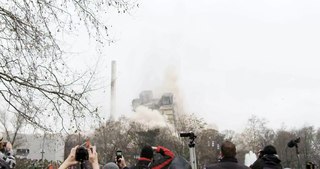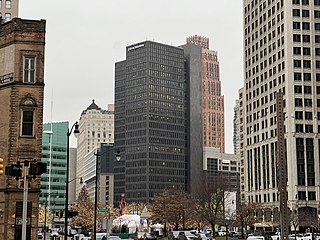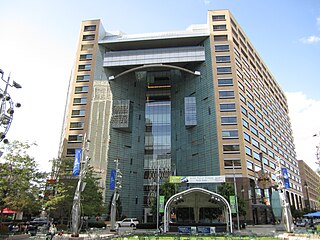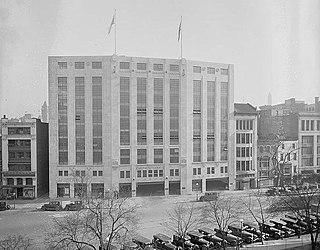
The Renaissance Center, commonly known as the RenCen, is a complex of seven connected skyscrapers in downtown Detroit, Michigan, United States. Located on the Detroit International Riverfront, the RenCen is owned and used by General Motors as its world headquarters. The complex includes a 73-story Marriott hotel at its center, surrounded by four 39-story office towers, connected by a large square podium containing public spaces, a conference center, retail stores, restaurants, and a company showroom.
The J. L. Hudson Company was an upscale retail department store chain based in Detroit, Michigan. Hudson's flagship store, on Woodward Avenue in Downtown Detroit, was the tallest department store in the world in 1961, and, at one time, claimed to be the second-largest department store, after Macy's, in the United States, by square footage.

The Woodward's Building is a historic building in the Downtown Eastside of Vancouver, British Columbia, Canada. The original portion of the building was constructed in 1903 for the Woodward's Department Store when that area of Cordova Street was the heart of Vancouver's retail shopping district. At one time, this was the premier shopping destination in Vancouver. The store was famous for its Christmas window displays, and its basement Food Floor and the "W" sign at the top of the building was distinctive landmark on the Vancouver skyline.

The Genesee Towers was the tallest building in Flint, Michigan, United States. It was demolished on December 22, 2013 after a period of inactivity and loss of occupancy.

In the controlled demolition industry, building implosion is the strategic placing of explosive material and timing of its detonation so that a structure collapses on itself in a matter of seconds, minimizing the physical damage to its immediate surroundings. Despite its terminology, building implosion also includes the controlled demolition of other structures, like bridges, smokestacks, towers, and tunnels. This is typically done to save time and money of what would otherwise be an extensive demolition process with construction equipment, as well as to reduce construction workers exposure to infrastructure that is in severe disrepair.

The First National Building is a skyscraper and class-A office center in Downtown Detroit, Michigan, within the Detroit Financial District. The building is located across the streets from Cadillac Tower and One Detroit Center, and stands next to the Vinton Building.

1001 Woodward is a 25-floor office building in Downtown Detroit, Michigan. It replaced the Majestic Building, a 14-story high rise on the same site. The building is located just south of the neighboring David Stott Building, at the corner of Woodward Avenue and Michigan Avenue overlooking Campus Martius Park. Constructed from 1963 to 1965, the building is designed in the International Style. It was listed on the National Register of Historic Places in 2013.

The Detroit City Hall was the seat of government for the city of Detroit, Michigan from 1871 to 1961. The building sat on the west side of Campus Martius bounded by Griswold Street to the west, Michigan Avenue to the north, Woodward Avenue to the east, and Fort Street to the south where One Kennedy Square stands today.

One Campus Martius is a building located in downtown Detroit, Michigan. It began construction in 2000 and was finished in 2003. It has seventeen floors in total, fifteen above-ground, and two below-ground, and has 1,088,000 square feet (100,000 m2) of office space. The high-rise was built as an office building with a restaurant, retail units, space for Compuware and a fitness center, as well as an atrium. The building now has Rocket Mortgage, Microsoft, Meridian Health, Plante Moran and Compuware as its major tenants.

Panorama Tower is a mixed-use 85-story skyscraper in Miami, Florida, United States. Located in the Brickell district of Downtown Miami, it is the tallest building in Miami, and the tallest building in Florida.

For the California beverage company, see Kern's

Docusign Tower, previously the Wells Fargo Center, is a skyscraper in Seattle, in the U.S. state of Washington. Originally named First Interstate Center when completed in 1983, the 47-story, 574-foot (175 m) tower is now the ninth-tallest building in the city, and has 24 elevators and 941,000 square feet (87,400 m2) of rentable space. The design work was done by The McKinley Architects, and it is owned by Chicago-based EQ Office.
Controlled Demolition, Inc. (CDI) is a controlled demolition firm headquartered in Phoenix, Maryland. The firm was founded by Jack Loizeaux who used dynamite to remove tree stumps in the Baltimore, Maryland area, and moved on to using explosives to take down chimneys, overpasses and small buildings in the 1940s. The company has demolished several notable buildings by implosion, including the Gettysburg National Tower, the Seattle Kingdome, and the uncollapsed portion of the Champlain Towers South condominium.

The Lower Woodward Avenue Historic District, also known as Merchant's Row, is a mixed-use retail, commercial, and residential district in downtown Detroit, Michigan, located between Campus Martius Park and Grand Circus Park Historic District at 1201 through 1449 Woodward Avenue and 1400 through 1456 Woodward Avenue. The district was listed on the National Register of Historic Places in 1999.

The Tower (formerly Block 82 Tower and Bank One Tower) is a 35-story building located in downtown Fort Worth, Texas bound by Taylor Street, Throckmorton Street, West 4th Street, and West 5th Street. At 488-feet, it is the fourth tallest building in Fort Worth. When it was completed in 1974, it was the tallest building in Fort Worth until the completion of the Burnett Plaza in 1983. On March 28, 2000, this tower was severely damaged by an F3 tornado; consensus was nearly reached to demolish the tower, but it was instead converted into the tallest residential building in the city.
Ocean Tower SPI was an unfinished, 31-story condominium in South Padre Island, Cameron County, Texas, United States, that was imploded when it was deemed unsafe to remain standing. Construction was halted in May 2008 when cracks formed in the building's supporting columns, and investigations revealed that the core of the skyscraper had sunk by more than 14 inches (360 mm). Though the developers initially vowed to fix the problem, studies discovered that repairs would have been too expensive, and plans for its demolition were announced in September 2009. At the time of its controlled implosion in December 2009 the building weighed 55,000 short tons (50,000 t), and it was the tallest reinforced concrete structure to be demolished in that way. It was nicknamed "Faulty Towers" and "The Leaning Tower of South Padre Island".

Demolition is the science and engineering in safely and efficiently tearing down buildings and other artificial structures. Demolition contrasts with deconstruction, which involves taking a building apart while carefully preserving valuable elements for reuse purposes.

The Landmark Tower was a 30-story skyscraper located at 200 West 7th Street in Downtown Fort Worth, Texas. Designed by Fort Worth architecture firm Preston M. Geren & Associates, Landmark Tower was the tallest building in the city from its opening in 1957 until the completion of the Fort Worth National Bank Tower in 1974. After being abandoned in 1990, the tower stood vacant for more than 15 years until it was demolished in 2006. It is one of the tallest buildings ever to be demolished.

Hudson's Detroit is an under-construction mixed-use development located in Downtown Detroit, Michigan, United States. Located on the former site of J.L. Hudson's Flagship Store, it is expected to be the second tallest building in Detroit as well as Michigan, at 208.7 meters (685 ft) and to be completed in 2024.

The Capital Garage was a ten-story parking garage that once stood at 1320 New York Avenue NW in downtown Washington, D.C. It was built for the Shannon & Luchs real estate firm and designed by local architect Arthur B. Heaton, whose landmark buildings in the city include Riggs National Bank, Stockton Hall, and the Churchill Hotel. The building was designed in the Streamline Moderne architectural style with Gothic Revival features. Ornamental details on its façade included bas-reliefs of automobiles and headlights as well as lion-headed grotesques. In addition to providing parking spaces, the Capital Garage also included a gas station, carwash, repair shop, and retail space.



















